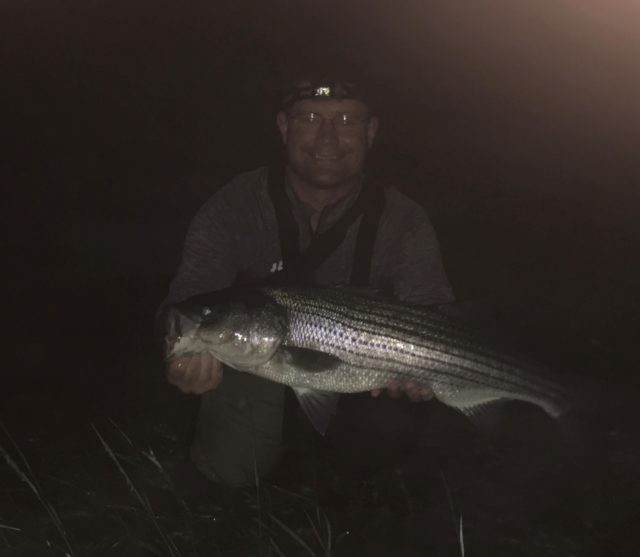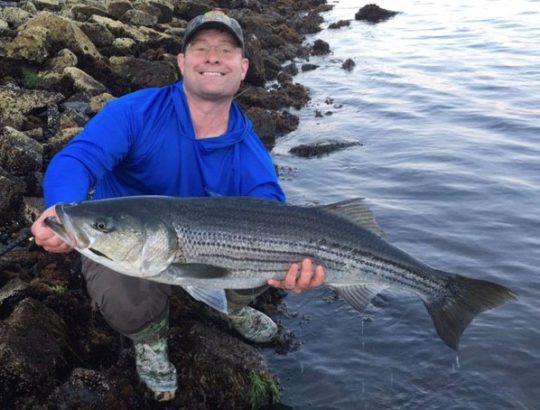
I have had a lot of guys tell me that fly fishermen usually out-fish spinning guys, and I can tell you that on schoolies, and when fish are keyed in on small bait, this may be the case.
But, at night, when chasing 30″+ fish, the spinning guys have the advantage. So, I am doing my best to learn why and solve for it.
My fishing partner is a surf-caster, and I have been primarily fly fishing this year. Looking at our logs as of the end of August, it’s pretty clear in the difference:
- Surf-caster: 148 striped bass, 11 fish over 40″, 51 keepers, and the rest schoolies.
- Me fly fishing: 292 striped bass, 1 fish over 40 inches, 28 keepers, and the rest schoolies. (I removed my surf-casting totals which are relative low numbers since I fly fished most of the year but include three bass over 20 lbs. and my biggest fish of year, a 31 lb. one–see below).
So, in our case, the data show the fly guy does catch the most fish, but in catching large fish, the surf-caster is double the keepers and 10 times the number of trophy-sized bass.
In reviewing my friend’s log, my log, and my recollections of the times we fished together, I came up with five themes that seem to really make the difference in size of fish caught this season.
Both of us fish primarily at night and usually do not fish past 7 am. If you exclude my six day- time (4 am to 10 am) trips to fish Cape Cod sand eel runs, that removes 181 stripers caught. Of those fish, none were keeper sized. In fact, most would be called “rats” due to their small size by a surf-caster.
Also, a common theme for both of us is we caught all our fish over 30″ between 10 pm to 7 am.
Here are the themes:
- Casting Distance: While fishing beaches at night does bring fish closer in,one of the best spots is where the current cuts back through the outer bar. It has been a real challenge to get a fly out into these spots, but my friend can just put on a 3 oz. needlefish or bottle plug with a teaser to fish these spots effectively. Often 20′ to 30′ has meant the difference between getting a bite or not.
- Water Column and Presentation: A large majority of the big fish have been caught at inlets with intense current and moderate to substantial depth. The surf-caster using a clip can quickly fish through this water using a darter, heavy needlefish, bucktail or jig with plastic up to 5 oz. Quickly covering different sections of the water column has been key to success and getting close to bottom has been critical more that 50% of the time.
- Changing Presentation Frequently: My friend will on average fish six different lures and presentation styles on a trip, and I am typically doing two changes.
- Locations Fished: The Cape Cod Canal is a unique scenario, but several other inlets and bridges pose similar challenges of no back casting room, fast current, and deep water. I have been trying to focus on spots I can make work for fly fishing and that has meant fewer big fish even though I know these other spots have higher potential for big fish.
- Lure/Fly Size: Average size of lure for surf-caster was seven inches, and my average size is around four inches for the entire season.

I am sure people can find exceptions to all of these observations, but consider them when you think about how you are fly fishing.
Based on what I have learned, I made some changes this season to help solve for the differences as they became apparent throughout the year. They have increased my percentage of big fish caught on my trips vs. schoolies.
Here they are:
- Casting Distance: In June, during the tail end of a herring run, keepers were sitting just out of my casting reach on my nine-weight for the Conomo Special fly (60′ is furthest I can throw this 10″ fly on this rod). My surf-casting buddy caught 21 fish with biggest being 34″, and I got a big goose egg.
After doing research, I decided two hand overhead casting with shooting heads of 550 grains or heavier was the clear solution to consistent distance and dealing with wind. I ended up buying a Thomas and Thomas Exocett surf two-hand overhead rod, and it has been a game changer for my striper fishing (most expensive rod investment of my entire adult life). Been teaching myself this style of casting and learning pretty quickly I am now consistently casting over 80′ with flies over 10″ long. I think with more practice over 100′ casts will be feasible, maybe even out to 120′.
The most incredible part though is the lack of fatigue from switching to TH overhead casting. I have bad shoulders from some serious injuries. Double hauling big flies for three hours leaves my shoulders in bad shape, but four hours of throwing same fly with TH overhead casts I am not sore at all. - Water Column and Presentation: Make a quiver of mini sink tips to attach to the end of a 30′ intermediate shooting head. I now carry the following lengths in T-17 tips: 3′, 6′, 9′, 12′, and 16′. I will guess what the heaviest one I should start with is and use that length, then if I hang up, to often switch to shorter tips and, if I am never hanging up, I use longer tips. If you are not losing at lease one to two flies a night fishing an inlet’s current, you are not in the strike zone.
- Changing Presentation Frequently: Surf-casters use a tactical angler clip so they can rapidly change lures instead of tying directly. I always used non-slip loop knots for my flies, but am now one month into using a 50 lb. TA clip, I can say it is worth considering. It appears to have no impact to my flies’ action, and I now change flies more frequently and my overall catch rate seems to be up. I also tied versions of the same fly pattern in different sinking rates, which is how a lot of plugs are designed (example: Super Strike Super “N” Fish lures) so I can change depth of presentation about two feet without having to change sink tip. These fine tuning adjustments are translating to more strikes already.
- Locations Fished: Been working on my Skagit game, and I have found it solves some of these issues, but it is not a perfect solution. I try to find a spot at these locations where I can make the TH Overhead work if I need to throw big flies. I am really having a hard time throwing flies over 10″any distance even with a 700 grain Skagit head. I am actually going to hire a casting instructor to work on this, but based on talking with some competition Skagit casters, there are limits on waterborne casts and fly size that may be impossible to over come. This means I may need to really think harder on fly design to get sparser and less bulk. Lot of work left in figuring out how to fish places like Cape Cod Canal on a fly rod.
- Lure/Fly Size: The magic number for a fly seems to be eight inches. When I fish flies that are longer, my percentage of schoolies is less than 30%. Anything shorter than eight inches, I catch over 50% schoolies. I am not saying you have to throw big flies to catch big stripers, but I am saying it help eliminates smaller stripers from biting. For me this helps my confidence at night which I think is more than half the battle in catching big fish.
Hope all this helps. Tight lines to all!
Discover more from BlogFlyFish.com
Subscribe to get the latest posts sent to your email.




Great information and well written. Especially interested in the two handed option as I am a fly fisherman moving to the Cape from the west coast.
Mark happy to discuss two hand options with you. I am actually in the process of writing an article for Thomas and Thomas on two hand overhead in the salt. There is not a lot of good information out there, but Rich Murphy’s book has some great information so I recommend picking that up. Its pretty much the bible of striped bass fly fishing for New England. He talks in detail about setting up his rods for different fishing applications. I have varied a little bit from his guidance but it is at the core of my thought process.
Easiest way to get in touch to discuss TH options is direct message on instagram @canalflyguy
I’ll send you a message over at MFCC where I’ve read your posts.
Dan, this was an awesome post! I have been looking into the 2 handed option too. I like to use both spin and fly options but need to practice with both. Probably because of my inexperience fly fishing for stripers, my spin gear generally catches more. I really like how you broke it down. Thanks for the good info. Now I just need to schedule more time for autumn run!
Joe, I had similar experiences when I first started throwing flies at night. First thing I think is key to say is presentation matters and confidence matters. Its hard to see what is going on and I realized that my presentations at night were not correct. I had to slow down and get to a point where I was certain through feel that my casts were landing where I wanted them and my flies were working the way they should. The other key is I like to hit lots of different spots with spin gear to find ones that produce, but for fly fishing I will only hit two or three spots most of the season at night. Being intimately familiar with spot allows you to make presentations correctly since you cannot see how conditions are changing and impacting your flies. I will be writing a follow up to this about night fly presentation in October that I think will be very helpful.
Excellent info and techniques, Dan. I too have started throwing a two-hander overhead for stripers in New England and have found some of my bigger fish at night. Thanks for this. Here’s to a good fall run.
Dean thanks and tight lines!
Dan, great post. Love it. I’ve been wanting to do more night fishing but honestly have been having issues as so far I’ve gotten the goose egg every time. This will help tremendously. And great stuff getting good info on the TH out there!
Chris will be posting a follow up next month that is exclusively on night fishing details. I struggled at first with night fly fishing and the article will be focused on reducing the learning curve for others.